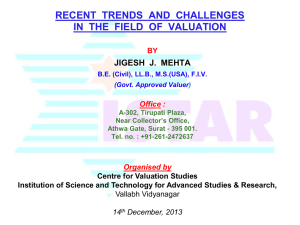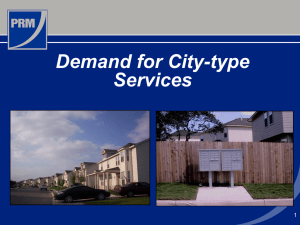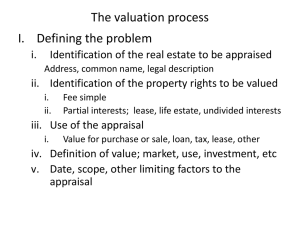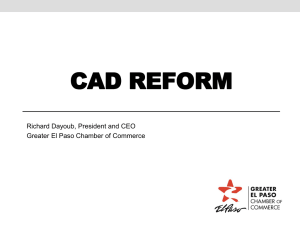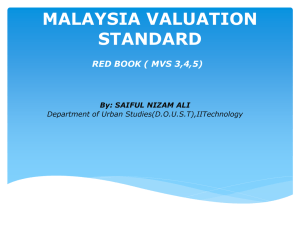PPT - istar
advertisement
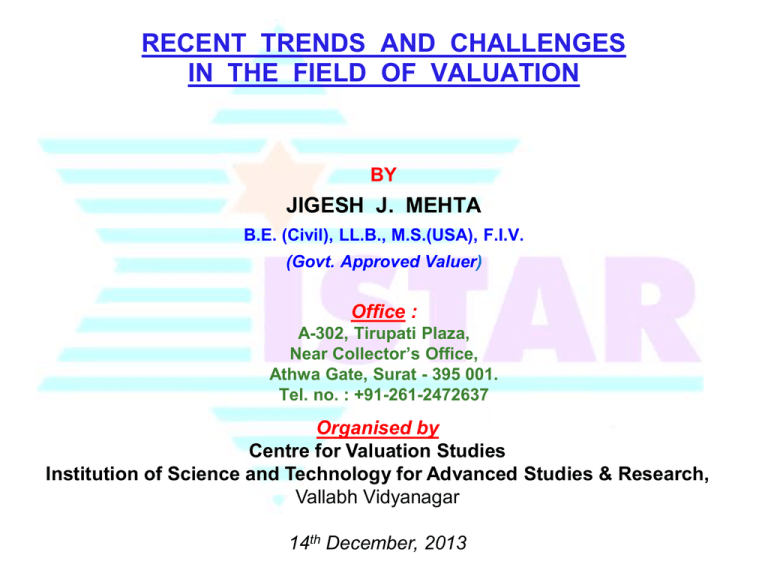
RECENT TRENDS AND CHALLENGES
IN THE FIELD OF VALUATION
BY
JIGESH J. MEHTA
B.E. (Civil), LL.B., M.S.(USA), F.I.V.
(Govt. Approved Valuer)
Office :
A-302, Tirupati Plaza,
Near Collector’s Office,
Athwa Gate, Surat - 395 001.
Tel. no. : +91-261-2472637
Organised by
Centre for Valuation Studies
Institution of Science and Technology for Advanced Studies & Research,
Vallabh Vidyanagar
14th December, 2013
Any challenge implies an opportunity….Infact, a prospect is associated
with every problem of valuation. Every challenging situation can usually
be addressed primarily by the application of ten commandments of
valuation. viz.
4 factors – legal, economic, social, physical/technical;
4 ingredients – utility, scarcity, transferability, demand/supply;
Value means Present Worth of Future Benefits, and
In any valuation exercise of tangible assets what is valued is not the
tangible thing but rights and interests arising out of ownership of
tangible assets.
NON-AVAILABILITY OF APPROVED SUBDIVISION PLANS
SUBPLOT no.8-A/2 paiki
east part (Mudra Mark-Fin
Pvt. Ltd.)
N
SUBPLOT no.8-A/1+2
paiki auctioned by
Dena Bank
SUBPLOT no.8-A/1
paiki west part (Mudra
Texturisers Pvt. Ltd.)
O
P
E
N
S
P
A
C
E
(6M)
COMBINED CONSTRUCTION ON TWO ADJOINING PLOTS BUT ONLY
ONE OFFERED AS LOAN SECURITY
Two brothers had purchased two adjoining plots. Instead of
constructing duplex-type bungalow with two independent units, they
had constructed only one(1) two-storeyed building covering both plots
in such a way that the ground floor was occupied by one brother and 1st
floor was occupied by another brother. The brother occupying ground
floor wanted loan facility against mortgage of his one plot. On
inspection, it was found that 1st owner’s ground floor was on his plot but
the 1st floor portion above it was under the possession of 2nd brother.
We could not inspect 1st floor occupied by 2nd brother as relations
between two brothers had strained and they were not on talking terms.
After the loan officer was informed about his fact, the bank decided to
reject this property as security.
AREAS OF COMMON USE SUCH ROADS, COP AND LOADING/UNLOADING TRANSFERRED
IN FAVOUR OF SOME SPECIFIC PLOTHOLDER(S) IN A LAYOUT
AMALGAMATION PLANS
SHARE OF UNDIVIDED LAND AREA NOT TRANSFERRED ALONGWITH BUILT-UP UNITS
5 shops on an upper floor of commercial building developed on 2060.50 sq.
m. land area out of the overall plot area of 4331.77 sq. m. including a twintheatre
Age of Building ~ 25 years; Future Life ~ 30 years
Leasehold land for 60 year period from 1971
Due to non-availability of lease deed for land, it could not be verified whether
there is provision (or not) for further extension of lease on the expiry of lease
period in year 2031.
Non-transfer clause of leasehold rights in land mentioned in sale deeds
for shops for transfer of superstructure only
Parent lease deed for land does not allow the leaseholder/developer of this
building to transfer or assign leasehold rights in land and therefore, the
developer of the land have the responsibility to pay the lease rent during the
period of lease
Prima facie, this appears to be a case of defective title. Careful study of the sale deeds hints that these shops are virtually transferred on
sublease (atleast for unexpired lease period ~ 18 years as on date of valuation) without any ground rent, at 100% premium.
Market Value basis will hold good only if advocate’s title report confirms that the shopholders in this building are entitled to leasehold rights
for undivided land corresponding to the shops by virtue of their possession/occupation because what is being valued is the
“shopholders’ interests in the shops” and NOT the shop itself. ELSE, the lender Bank will be not be able extend charge to the
undivided land area as only the superstructure will be mortgaged
It is noteworthy that out of the prevailing composite rate of Rs.5500-6000 per sq. ft. ASSUMING THAT GROUND LEASE IS FURTHER
RENEWABLE AFTER EXPIRY OF PRESENT LEASE TERM (considering lease in perpetuity equivalent to freehold land), the construction
component would not exceed 20-25% while the remaining 75-80% is attributable to the FSI value for corresponding undivided land.
What would happen if the building is wholly destroyed or becomes permanently unfit for use due to fire or flood or earthquake or other
such irresistible force duering loan period? Insurance is taken only for construction but if the developer does not agree to give land for
re-construction, a dead-lock will be created and one does not know the final outcome if the matter is taken to court as the developers will
argue that only construction was sold and that the land right was never transferred. This interpretation could be very harmful. Once this
submission is clearly made by the developer, any challenge to counter him in court of law would be a tedious matter.
BASEMENTS APPROVED FOR HOUSEHOLD STORAGE
Garment Showroom on Lower Ground floor
Existing area (including excess area than that shown in plan) and change of use from household store to
commercial use are regularized by payment of impact fees.
The moot question is whether the sale / transfer of basement (approved as household store) to someone other
than shareholder/member of the society be considered void ab-initio in view of the decision in the case of
Nahalchand vs. Panchali Society ?
There are two school of thoughts proposing different approach to this kind of problem: (i) that opine that it is
case of clear title irrespective of whether the corresponding undivided land area is transferred or not, while (ii)
that consider it is a case of defective title because FSI of basement is exempted and the land area ought to
have been conveyed fully to the members on the upper floors.
UNAUTHORISED CONSTRUCTION THAT CAN BE REGULARISED
1.
2.
Area of the property (actual) :
Area of property (permitted as per
approved plan/building byelaws).
GF : (14’ x 45’’)
= 630 sq. ft.
FF : (17’ x 48’)
= 816 sq. ft.
SF : (17’ x 48’)
= 816 sq. ft.
St cabin :
(7’ x 14’) =
Total Built-up Area
= 2,360 sq. ft.
Ground floor (approved) = 420 sq. ft.
First floor (regularisable)= 420 sq. ft.
Second floor (regularisable)
Approved Built-up Area = 1260 sq. ft.
98 sq. ft.
= 420 sq. ft.
Reference is drawn on the case of Dr. Shankarappa vs. The
Commissioner-Bangalore City Corporation decided by the National
Consumer Disputes Redressal Commission, New Delhi decided on
22 March-2006.
When there is a provision for regularization of construction by the
local authority under any Government notification, the deviation
even if it is unauthorized, shall be regularized by taking penalty.
VALUATION FOR FLAT ON HIRE-PURCHASE AGREEMENT FOR CAPITAL
GAINS TAX
Flats in a residential colony of Gujarat Housing Board were allotted on Hire Purchase basis in the year
allotted in 1970 with a monthly instalment of Rs.86 payable till September-1990. If any flatholder
intended to sell his flat prior to September 1990, he would have to pay all outstanding dues /
instalments to the Gujarat Housing Board or handover the possession back to Gujarat Housing Board.
The entire scheme was purchased by a developer in the year 2012-13 and we are required to give
valuation report as on 1-04-1981 for capital gains tax purpose.
Market Value as on 1-04-1981 (if all instalments cleared)
=
388 sq. ft. @ Rs.80 per sq. ft.
=
Rs.31,040
Present Value as on 1-04-1981 (considering outstanding instalments payable)
=
Rs.31040 - outstanding liability as on 1st April 1981
=
Rs.31040 - present value of outstanding liability of 114 monthly instalments of Rs.86 payable till
September 1990
=
Rs.31040 - (Monthly Instalment x Month’s Purchase)
=
Rs.31040 - Rs.86 x {1 - [1/(1+R/m)m.n]}
where
n = 9.5 years, R = 8%,
(R/m)
m = 12 instalments per year
=
Rs.31040 - (Rs.86 x 79.20)
=
Rs.31040 - Rs.6813
= Rs.24,227
As per the amendment made in the provisions of Capital Gains Tax, the above value of the property is
to be enhanced by 8.52 times to give effect of Cost Index for the Assessment Year 2013-14 (i.e.
Financial Year 2012-13).
Hence, Indexed Cost of Acquisition as on date of sale
=
Rs.24,227 x 852
= Rs.2,06,414
100
BOMBAY STAMP DUTY ACT-1958
Case study of basement put for sale by
owner Bank
(i)
Demand and marketability is poor due to lack of
ventilation below ground level and seepage from
walls.
(ii) Utility is very limited (only as godown, dormitory or
more effectively for two-wheeler parking through
mechanised lift of the owner of two level
commercial parking operated by the developer of
this building).
(iii) The guideline composite rate prescribed in the
Jantri (w.e.f. 18-04-2011) for commercial basement
in new building at this location is 80% Rs.89125 per
sq. m. = Rs.71300 per sq. m. (i.e. Rs.6626.40 per
sq. ft.). Depreciation is allowed @ 1.2% per year,
i.e. 1.2% x 25 years x Rs.6626.40 per sq. ft. =
Rs.1988 per sq. ft. Thus, the present rate after
depreciation ~ Rs.(6646.40 – 1988) = Rs.4658.40
per sq. ft. carpet area is much higher than the
prevailing market rate.
However, as per the
provisions of Jantri, the conveyance deed for this
property will have to be executed paying a stamp
duty on Jantri rate eventhough the auction value
may be lesser. Alternatively, the seller Bank should
get prevaluation / adjudication done under section
31 of the Bombay Stamp Duty Act.
PROSPECTS UNDER CAPITAL GAINS TAX
SECTION 50 C of the Income Tax Act
BOMBAY STAMP DUTY ACT-1958, SECTION 31
(Adjudication as to Proper Stamps)
Section 50 C(2) of I.T. Act – Reference to Valuation Officer
Section 16A(4) of W.T. Act - Valuation Officer to serve a notice
Section 16A(5) of W.T. Act - Valuation Officer to consider objections and evidences
Valuer’s Role
To prepare reasoned submission supported by accepted principles of valuation and
court judgements mainly on the following two aspects :
• Sale Instances relied upon must be comparable
• Rented properties must be valued by rent capitalisation method
• Bharat Bijlee Ltd. vs. State of Maharashtra, 2003
PROSPECTS UNDER WEALTH TAX ACT
Exemptions are covered under Section 2(ea) and Section 5
(A)
Any house that the assessee may occupy for the purpose of
business or profession carried on by him.
(B)
Any residential property that has been let out for a minimum period
of three hundred days in the previous year.
(C)
Any property in the nature of commercial establishments or
complexes.
(D)
Urban Land such as land on which construction of a building is
not permissible under any law for the time being in force or the land
occupied by any building constructed with the approval of the
appropriate authority or any unused land held by assessee for industrial
purposes for a period of two years from the date of acquisition by him.
According SECTION 5(VI), one house or part of a house or a plot of land (not
exceeding 500 sq. m.) belonging to an individual or H.U.F. is exempted.
Concessional valuation for a house can be worked out by applying provisions
of Schedule-III of Wealth Tax Act.
OTHER AVENUES IN VALUATION
In addition to the routine valuations for banks, taxation, stamp-duty and visa purpose, the following avenues may
be explored by valuers.
1.
Asset Listing Verification & Valuation for Municipal Corporation Assets (MODEL NATIONAL MUNICIPAL
ASSET VALUATION METHODOLOGY MANUAL published by Ministry of Urban Development, January 2009) for
financial statements
2.
Valuation for Dispute Resolution –
a.
Expert Witness
b.
Mesne Profit
c.
Arbitration/ Small Causes Court
3.
Fixation of Royalty i.e. Rent – normally in High Court
4.
Technical Due-Diligence of Project – FSI/ Approval Status, etc
5.
RE Project Feasibility reports
6.
Valuation for REITs - Recent draft SEBI Regulation
7.
Lender’s Engineer – Surveillance Report
8.
Valuation of Pre-Leased properties – Concept of Investment Value based on Investor ROI
9.
Land Acquisition Cases
10.
IFRS/ Purchase Price Allocation/ Impairment
11.
Certification for work done and balance work of the developer in order to determine the Value-Added Tax
(VAT) payable by a developer to the State Government
(refer Supreme Court decision on 26-September 2013 in M/s. L & T vs. State of Karnataka which states that the
activity of construction undertaken by the developer would be works contract only from the stage the developer
enters into a contract with the flat purchaser. The value addition made to the goods transferred after the
agreement is entered into with the flat purchaser can only be made chargeable to tax by the State Government).
Thank You
